Askania Peilscheibe
6x25 PeilvisierDiese Peilscheibe für den Gebrauch bei der Luftwaffe - daher mit Anforderungszeichen FL. 23250-1 - wurde von der Askania Werke A.G. 1939 gefertigt; dies ist an dem angenieteten Geräteschild unter der Peilscheibe zu entnehmen. Die Peilscheibe ist mit einem 6x25 Monokular als Visier ausgestattet und kann in einem grauen Holzkasten inklusive eines gelblich-grünen Filterglases und einem Stellschlüssel transportiert werden. Der Kasten selbst hat ebenfalls ein aufgenietetes Askania Firmenschild mit Werksnummer "W.998343" sowie ein Schild mit dem Anforderungszeichen FL. 23250-3. Im Deckel der Kiste ist eine Geräteabbildung mit Bedienungsanleitung. Diese und die Peilscheibe sind mit einem roten Abnahmestempel "BAL 770" der Bauaufsichtsleitung des Reichluftfahrtministeriums gestempelt (beim Monokular gibt es einen weiteren Stempel am Okualrdeckel mit "BA 1981" und ein weiterer mit "110" , welcher auch evtl. eine verwqschne 770 ist). |
6x25 Director SightThis aiming circle for the airforce use - hence it ocmes with a order code (Anforderungszeichen) FL. 23250-1 - was made by Askania Werke A.G. in; this is marked on the riveted instrument plate at the bottom side of the circle. The aiming circle is equipped with a 6x25 monocular as a sight. Both can be stored in a grey painted wooden transport case, which also includes a yellowish-green filter glas and a adjustment tool. The case itself also has a revieted Askania compayn plate with factory number "W.998343" as well as a palte with the order code "FL. 23250-3". On the inner side of the case's lid is a paper with a picture of the instrument and a manual. The paper and the aiming circle bear a red acceptance stamp "BAL 770" of the construction supervision head office of the Empirial Airforce Ministry (Bauaufsichtsleitung des Reichsluftfahrtministeriums) (beim Monokular gibt es einen weiteren Stempel am Okualrdeckel mit "BA 1981", and one with "110", probably blurred "770"). |
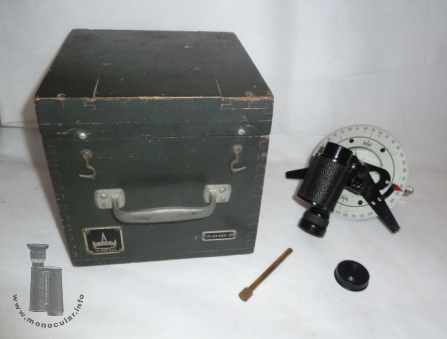
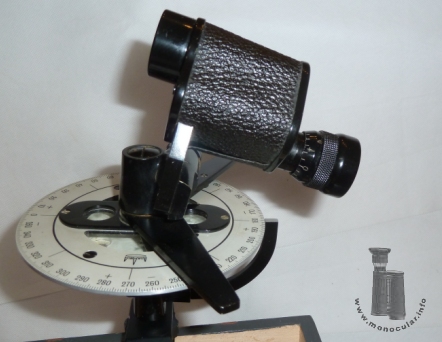
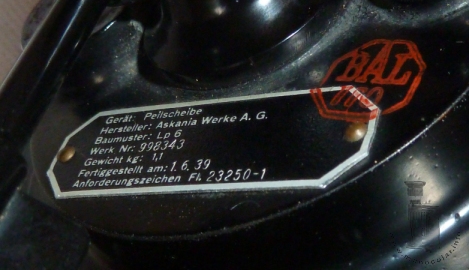
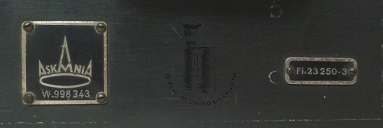
| Das 6x25 Monokular ist mit einer kippbaren Halterung mittig auf der Peilscheibe montiert. Die Aluminiumteile sind schwarz lackiert, das Gehäuse hat eine Hartgummiummantelung und die Augenmuschel ist aus Bakelit. Das Okular hat eine umlaufenden Dioptienskal mit Kennzeichnungne für 0, + und -. Der untere Deckel ist zweifach, der obere dreifach verschraubt. Die Porro-1-Prismen werden im Gehäuse mit dicken Aluminiumklammern, die sich unter der Ummantelung mit Schrauben justieren lassen, festgehalten. | The 6x25 monocular is mounted with a tiltable holder in the center of the aiming disc. The aluminum parts are painted black, the housing has a hard rubber coating and the eyecup is made of Bakelite. The eyepiece has a full dioptre scale with markings for 0, + and -. The lower cover has two, the upper cover three screws. The Porro I prisms are held in the housing with thick aluminum clamps that can be adjusted with screws which are under the covering. |
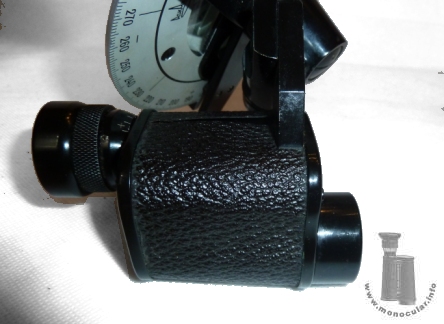

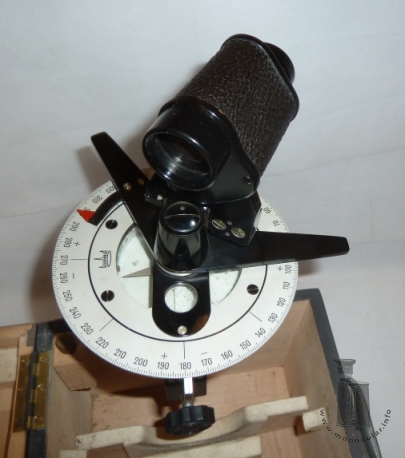
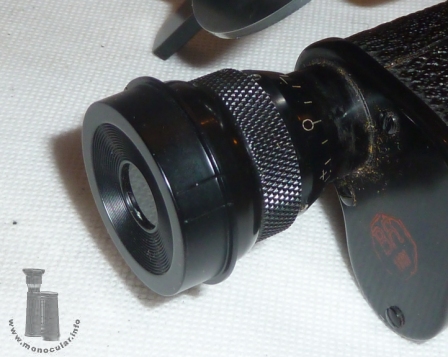
| Die weiße Peilscheibe - mit zwei Askania-Logos gekennzeichnet - ist in 360 Gradstrichen aufgeteilt. Je 10 Grad gibt es eine Ziffernbeschriftung sowie bei 0, 90, 180 und 270 Grad eine + und - Markierung. Unter der Scheibe ist im Sockelggehäuse ein Kompass bzw. Kompassnadel und zur Nivelleirung eine Blasenlibelle eingebaut. Die Nadel kann mittels eine Stellknopfes unten am peilscheibengehäuse festgestellt werden. Das Scokelgahäuse hat unten einen Gewindezapfen zur Befestigung auf einem Stativ. Der Zapfen hat einen Viertelkreis-Arm mit obigen Referenzstich, de bei mDrehen an der Peilscheibenskala entlang wandert. Der Referenzstrich bzw. der Zapfen mit dem Arm kann mit einer Flügeschraube arreteirt werden. Der Trägerarm des Monokulars ist oben auf der Peilscheoibe montiert und hat zwei Boomerang-förmige Griffe zum Drehen des Monokulars. Am rechten Griff ist wiederum ein Zeiger mit roter Spitze der die horizontale Abweichung auf der Scheibenskala anzeigt. | The white disc - marked with two Askania logos - is divided into 360 degrees. Every 10 degrees are marked with numbers and at 0, 90, 180 and 270 degrees there is a + and - mark. A compass or compass needle and a bubble level for leveling are installed under the disc in the base housing. The needle can be locked using an adjusting button on the bottom of the disc housing. The base housing has a threaded rod at the bottom for mounting on a tripod. The rod has a quarter-circle arm with a reference line on the top end; it moves along the scale dial when turning. The reference line or the pin with the arm can be locked with a wing screw. The monocular holder is mounted on top of the sighting disc and has two Boomerang-shaped handles for rotating the monocular. On the right handle is again a pointer with a red tip that shows the horizontal deviation on the disc scale. |
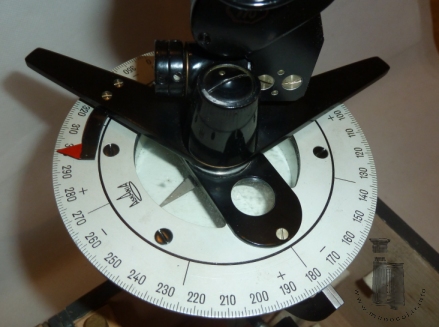
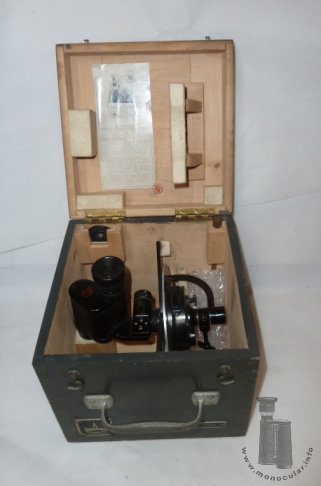
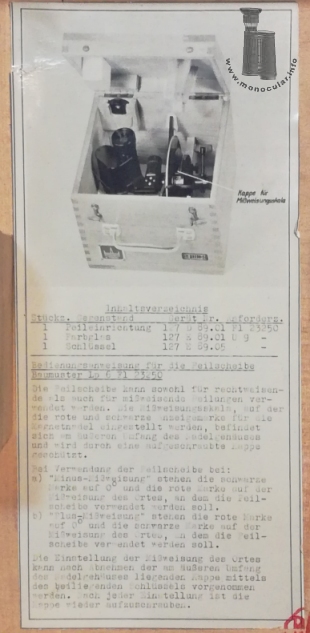
| Die Bedienungsanweisung für die Peilscheibe "Baumuster LP 6 FL.23250" im inneren Deckel der Kiste besagt, dass das Instrument für rechtweisende als auch missweisende Peilungen verwendet werden kann. Um den Kompass bei Missweisugnen des Standorts zu justieren, kann man unter einer abschraubbaren Abdeckkappe an der Sockelseite mit dem beiligenden Sechskant-Mutterrnschlüssel zwei Einstellschrauben lockern und fixieren. (s. Foto) | The instruction paper of the aiming circle (pattern LP 6 Fl.23250) on the inside of the case's lid says that it can be used for both directional and misleading bearings. To adjust the compass for misleading bearings on a certain location you can loosen and fix two set screws with a hexagon wrench, when yo uhave screwed off the cover ont he side of the base hosuing (cf. photo). |
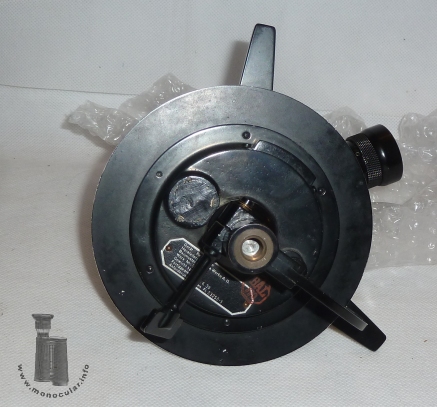
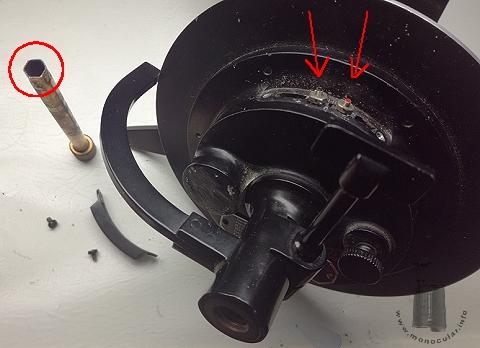
| Die Peilscheibe mit dem Monokular wiegt 635g. Die Kiste mit dem Zubehör 1274g. Beide Angaben stimmen mit der Gewichtsangabe (1,1 kg) auf dem Kennzeichnungsschild nicht überein. die Peilscheibe hat einen Durchmesser von 128mm, mit dem Sockel ist sie ca. 20mm hoch. Die Höhe mit Stativzapfen und dem Monokular ist 18cm. Das Monokular ist 99-107mm lang. Das Gehäuse ist oben 47x47mm und unten 50x50mm breit die Objektivhülse misst 30mm, das Okularstück 20mm, der Fokussierugnsring 30mm und die Augenmuschel 32mm im Durchmesser. Der Holzkasten ist 19x19x18,2cm. | The sighting disc with the monocular weighs 635g. The box with the accessories weighs 1274g. Both data do not correspond to the weight (1.1 kg) given on the label. The sighting disc has a diameter of 128mm, and with its base it is approx. 20mm high. Its height with tripod rod and the monocular is 18cm. The monocular is 99-107mm long. The housing is 47x47mm wide at the top and 50x50mm wide at the bottom, the lens frame measures 30mm, the eyepiece 20mm, the focusing ring 30mm, and the eyecup 32mm in diameter. The wooden box measures 19x19x18.2cm. |
Fotos: Zeun

